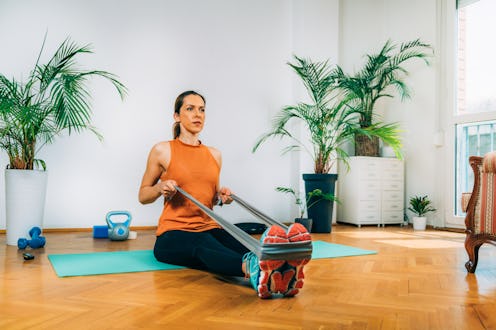Fitness
The simplest moves can make the biggest difference.
This happens betweenbones and tissue in your joints.
Most commonly, shoulder bursitis stems from overuse orrepetitive motion.

Typically, these involve overhead movements, Salazar tells Bustle.
Symptoms typically include pain, swelling,reduced movement or motion, and weakness in the shoulder.
It might also be hard to lift your arms up due to pain or stiffness.
Some people experience a sharp, sudden pain with certain movements, he adds.
Sometimes the symptoms of bursitis can be similar to other issues, liketendonitis, Salazar says.
Here are seven shoulder bursitis exercises to try that should help set things right.
Stand with your arms resting by your sides.
Squeeze your shoulder blades together.
For a visual, think about trying to pinch a ball between your shoulder blades.
Hold for five seconds then relax.
Do 10 to 12 squeezes 2 to 3 times a day.
2Shoulder Shrugs
This subtle move can also provide relief.
Over time, it can help decrease bursitis pain.
Stand in a neutral position.
Shrug or raise your shoulders up to your ears.
Hold your shoulders up for two seconds.
Release back down then shrug again.
Repeat 10 times.
This can help to reduce the strain on the bursa and improve symptoms.
Sit on the floor with legs extended in front of you, feet slightly wider than hip-width apart.
Loop aresistance bandaround your feet and hold either end.
Row by pulling the band back toward your chest.
Maintain a straight back.
Squeeze your shoulder blades together at the top of the move.
Pause for two seconds before slowly releasing the band back to starting position.
Try 3 sets of 10 reps.
4Wall Push-Ups
McSorley also recommendswall push-ups.
They help to stretch and strengthen the muscles around the shoulder, she says.
They also help toimprove the range of motion.
Place your palms against a wall shoulder-width apart.
Walk your feet back until youre in a plank position with your body straight from head to heels.
Bend your elbows.
Slowly lower yourself toward the wall, stopping when your nose nearly touches it.
Press back up to the starting position.
I tend to tell people to do them at breakfast, lunch, and dinner, Salazar says.
This shoulder stretch can help relieve pain while loosening the rotator cuff.
Hold the elbow of the affected arm with your other hand.
Use that hand to pull the affected arm gently up and across your body.
Feel a stretch on the back of your shoulder.
Hold for up to 30 seconds.
Repeat 3 to 5 times.
Aim to do this stretch 1 to 3 times a day.
6Anterior Shoulder Stretch
Salazar also recommends thisstretchfor shoulder bursitis.
Start by reaching the hand of your affected arm towards your back pocket.
Reach your other hand behind you and hold the affected arm by the wrist.
Keep the palm of your affected arm facing out.
Gently pull the arm upwards until you feel a stretch.
For a variation, use a wall for support.
Lie on your back or kneel.
Hold a weightless stick or dowel (like a broom handle) with both hands.
Keep your elbows straight as you slowly raise your arms over your head.
Repeat 3 to 5 reps.
Studies referenced:
Castelein, B. Modifying the shoulder joint position during shrugging and retraction exercises alters the activation of the medial scapular muscles.
Epub 2015 Sep 16.
Faruqi, T. (20220> Subacromial Bursitis.
In: StatPearls [Internet].
Treasure Island (FL): StatPearls Publishing; 2022 Jan-.
Available from:https://www.ncbi.nlm.nih.gov/books/NBK541096/.
Klatte-Schulz, F. (2022).
Subacromial Bursa: A Neglected Tissue Is Gaining More and More Attention in Clinical and Experimental Research.
VanBaak, K. (2020).
Shoulder Conditions: Rotator Cuff Injuries and Bursitis.